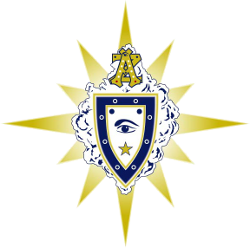Top Qs
Timeline
Chat
Perspective
Alpha Zeta (professional)
American professional fraternity for agriculture and natural resources From Wikipedia, the free encyclopedia
Remove ads
Alpha Zeta (ΑΖ) is an honorary professional fraternity for students and industry professionals in agricultural and natural resources fields.[1][2] It was founded in 1897 at Ohio State University and was the first collegiate society for agriculture.[1]
Remove ads
History
Summarize
Perspective
Charles W. Burkett and John F. Cunningham, roommates and students at the College of Agriculture at Ohio State University, founded the Alpha Zeta fraternity on November 4, 1897.[2] Three years prior, Burkett and Cunnigham had the idea of forming an organization to support agricultural students, create fellowship, and promote agriculture.[3] They recruited ten other agriculture students who became the fraternity's charter members, including [3]
- Arthur G. Abbott
- Charles Burkett
- Clarence Clawson
- John Cunningham
- Vernon H. Davis
- Donnelley H. Duncan
- Oscar Erf
- Marion Imes
- Arthur G. McCall
- Carl J. Miller
- Charles B. Stewart
- Leonard C. Warden
Alpha Zeta formed as a professional fraternity but became an honorary fraternity in 1936.[4] Its chapters were limited to land-grant institutions until 1951.[5]
At the fraternity's 1940 Conclave, a proposal was presented to open membership to non-white males.[3] This was presented at each Conclave for twelve years, finally passing in 1952.[6] Also in 1952, a proposal to admit women was defeated with a tied vote.[3] The fraternity's constitution was amended in 1972, allowing its chapters to initiate women.[3]
The fraternity was headquartered in Washington, D.C. in the 1960s.[6] It was located in Lafayette, Indiana from 1974 to 1994, when it moved to St. Louis, Missouri.[7] Its headquarters is currently located in Paducah, Kentucky. As of 2023, Alpha Zeta has chartered 74 chapters.[1]
Its print publication was the Quarterly of Alpha Zeta, first published in the early 20th century.[8][9][6] AZ News is now its primary publication.[2]
Remove ads
Symbols
The fraternity's badge is a monogram of the letter Α on top of the letter Ζ, with a small star at the center of the Α.[6][2] Its key is the shape of two overlapping circles in gold and black.[6][2] Its colors are old gold (mode) and sky blue.[6][2] Its flower is the pink carnation.[10]
Charitable activities
In 1942, Alpha Zeta began issuing scholarships to a select number of members for graduate studies.[6] The Washington, D.C. Alumni Association helped form the National Alpha Zeta Foundation of America, Inc. in 1960, allowing the expansion of the scholarship program.[11][6] The foundation accepts and manages donations for "scientific, educational and charitable purposes which best advance agriculture for the public good."[11]
The Alpha Zeta Foundation, Inc. was formed in Indiana on April 4, 1984, to oversee the fraternity's national scholarship program and to support its leadership development program.[11]
Governance
The fraternity is overseen by a seven-member High Council that is elected by student representatives of each chapter at Biennial Conclaves held on odd calendar years.[2] The council includes the High Chancellor, High Censor, High Scribe, High Treasurer, High Chronicler, Alumni Representative, and student representative.[2] Alpha Zeta also has staff who oversee the fraternity's operations and communications.[2]
Remove ads
Membership
To be eligible for membership in Alpha Zeta, students must be majoring in agriculture or a related field, must have completed one year of study, and must be in the upper two-fifths of their class.[2] Prospective members are also evaluated for character and leadership.[2]
As of 2023, Alpha Zeta has initiated 125,000 members and has 1,000 active members.[1] Its membership types are student, alumni, associate, and honorary.[6] Honorary members can be nominated by chapters every ten years after their Charter date.[12]
Membership was limited to white males for the fraternity's first 55 years but became open to any male in 1952.[3] Membership was made open to women starting in 1972.[3]
Remove ads
Chapters
Summarize
Perspective
Following is a list of Alpha Zeta chapters.[13][5][14][6] Active chapters are indicated in bold. Inactive chapters are in italics. Chapters are named in some way concerning agriculture or after the locality of the chapter.
Remove ads
Notable members
Remove ads
See also
References
Wikiwand - on
Seamless Wikipedia browsing. On steroids.
Remove ads


